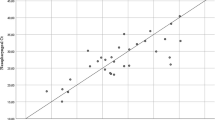Abstract
The purpose of this investigation was to evaluate the effectiveness of posterior pharyngeal and nasopharyngeal swabs in identifying and quantifying meningococcal carriage. Two swab samples were obtained from 564 healthy adolescents aged 15–19 years, the first taken from the posterior pharyngeal wall through the mouth and the second through the nose. Bacterial genomic DNA was extracted and screened for Neisseria meningitidis by means of two separate singleplex real-time polymerase chain reactions (real-time PCRs) in order to identify the CtrA and sodC genes. Subsequently, N. meningitidis-positive samples underwent a further singleplex real-time PCR in order to determine the N. meningitidis serogroup, and the DNA was quantified by means of standard curves. Thirty-seven subjects (6.6 %) were found to be carriers of N. meningitidis. The most frequently carried serogroup was serogroup B (15 cases, 40.5 %); serogroups A, Y, X, W135 and Z were found in, respectively, two (5.4 %), five (13.5 %), four (10.8 %), three (8.1 %) and one subject (2.7 %); the serogroup was not identified in seven cases. The detection of carrier status was significantly more frequent using posterior pharyngeal swabs (5.3 % vs. 2.1 %; p = 0.004), which also contained a significantly larger number of N. meningitidis genomic copies (4.91 ± 1.39 vs. 2.50 ± 0.8 log10 genomic copies/mL; p < 0.001). Posterior pharyngeal swabs seem to be better than nasopharyngeal swabs for detecting N. meningitidis carriage in large-scale epidemiological studies because they identify a significantly larger number of pathogen carriers and recover a significantly larger amount of bacterial DNA.
Similar content being viewed by others
References
Chang Q, Tzeng YL, Stephens DS (2012) Meningococcal disease: changes in epidemiology and prevention. Clin Epidemiol 4:237–245
Yazdankhah SP, Caugant DA (2004) Neisseria meningitidis: an overview of the carriage state. J Med Microbiol 53:821–832
Roberts J, Greenwood B, Stuart J (2009) Sampling methods to detect carriage of Neisseria meningitidis; literature review. J Infect 58:103–107
Hoeffler DF (1974) Recovery of Neisseria meningitidis from the nasopharynx. Comparison of two techniques. Am J Dis Child 128:54–56
Orr HJ, Gray SJ, Macdonald M, Stuart JM (2003) Saliva and meningococcal transmission. Emerg Infect Dis 9:1314–1315
Jordens JZ, Williams JN, Jones GR, Heckels JE (2002) Detection of meningococcal carriage by culture and PCR of throat swabs and mouth gargles. J Clin Microbiol 40:75–79
Olcén P, Kjellander J, Danielsson D, Lindquist BL (1979) Culture diagnosis of meningococcal carriers: yield from different sites and influence of storage in transport medium. J Clin Pathol 32:1222–1225
Dolan Thomas J, Hatcher CP, Satterfield DA, Theodore MJ, Bach MC, Linscott KB et al (2011) sodC-based real-time PCR for detection of Neisseria meningitidis. PLoS One 6:e19361
Wang X, Theodore MJ, Mair R, Trujillo-Lopez E, du Plessis M, Wolter N et al (2012) Clinical validation of multiplex real-time PCR assays for detection of bacterial meningitis pathogens. J Clin Microbiol 50:702–708
Mothershed EA, Sacchi CT, Whitney AM, Barnett GA, Ajello GW, Schmink S et al (2004) Use of real-time PCR to resolve slide agglutination discrepancies in serogroup identification of Neisseria meningitidis. J Clin Microbiol 42:320–328
Tettelin H, Saunders NJ, Heidelberg J, Jeffries AC, Nelson KE, Eisen JA et al (2000) Complete genome sequence of Neisseria meningitidis serogroup B strain MC58. Science 287:1809–1815
Germinario C, Tafuri S, Napoli C, Montagna MT, Balducci MT, Fortunato F et al (2010) Young-adult carriers of Neisseria meningitidis in Puglia (Italy): will the pattern of circulating meningococci change following the introduction of meningococcal serogroup C conjugate vaccines? Hum Vaccin 6:1025–1027
Istituto Superiore di Sanità. Gruppo di lavoro ICONA (2009) ICONA 2008. Indagine di copertura vaccinale nazionale nei bambini e negli adolescenti. 8:118. Rapporti ISTISAN 09/29
Istituto Superiore di Sanità. Dati di sorveglianza delle malattie batteriche invasive aggiornati al 20 agosto 2012 (versione 25/9/2012). Available online at: http://www.simi.iss.it/files/Report_MBI.pdf. Accessed 6 December 2012
Acknowledgements
This study was supported by a grant from the Italian Ministry of Health (Bando Per Giovani Ricercatori 2007).
Conflict of interest
The authors have no potential conflict of interest to declare.
Author information
Authors and Affiliations
Corresponding author
Rights and permissions
About this article
Cite this article
Esposito, S., Zampiero, A., Terranova, L. et al. Comparison of posterior pharyngeal wall and nasopharyngeal swabbing as a means of detecting the carriage of Neisseria meningitidis in adolescents. Eur J Clin Microbiol Infect Dis 32, 1129–1133 (2013). https://doi.org/10.1007/s10096-013-1856-2
Received:
Accepted:
Published:
Issue Date:
DOI: https://doi.org/10.1007/s10096-013-1856-2




